Tags
"internship advantage"
The Siegel Salmon Restoration Internship: Part 3
Some things about the American beaver:
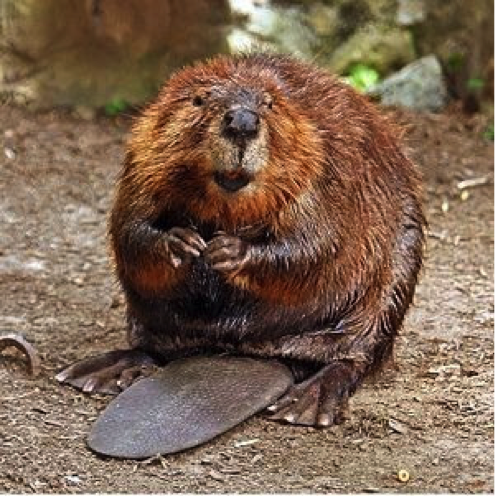 Figure 1. The American beaver.
Figure 1. The American beaver.
When Doug, the Land Trust’s Big River Program Manager, first proposed the idea to me, I was more than a little surprised. We had spent so many weeks talking about large woody debris, culvert passage, and road decommissioning that it seemed almost impossible for something so cute and furry to help salmon. I suspended my disbelief and delved into research. Lo and behold, beaver reintroduction projects have proven successful throughout the Pacific Northwest, improving salmon habitat and raising fish numbers. It isn’t an easy choice by any means; reintroducing beavers on one property requires monitoring their survival, distribution shifts, and population growth. However, a surprisingly large body of literature exists on the remediation of these issues, and has been used in other beaver reintroduction projects. So, why not try it?
Continue reading The Siegel Salmon Restoration Internship: Part 3
The Siegel Salmon Restoration Internship: Part 2
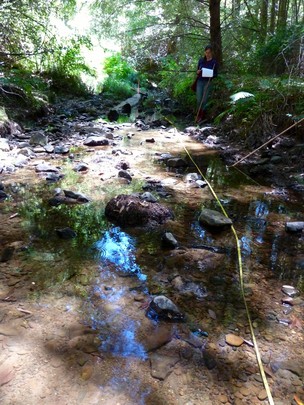
Figure 1. In-stream measurements at Russell Brook. Although picturesque, the stream is not very hospitable for rearing and migrating salmon.
The large woody debris project forges ahead here at the Mendocino Land Trust. Two weeks ago, I went into the stream at Russell Brook along with Doug (Big River Program manager) and Nicolet (Trails & Stewardship Coordinator). We walked the length of the project area (about a half mile) and took some basic stream measurements (Figure 1) that quantitatively describe the area and determine the baseline level of viable salmon habitat. Spoiler alert: it’s pretty low. Pools are infrequent and shallow, meaning that salmon don’t have good rearing habitat, and cannot rest during upstream migration. Water temperature is high, which poses a problem for these cold-water inhabitants. However, only a couple hundred feet up the stream, where large woody debris has already been installed, deep pools swell over the tops of waders (a bittersweet discovery).
The California Conservation Corps (CCC) has now begun the arduous process of hauling and anchoring huge logs in the stream according to detailed plans (Figure 2). I’ll get to see the crews in action in a couple weeks while conducting an inventory of the large woody debris that is in place.
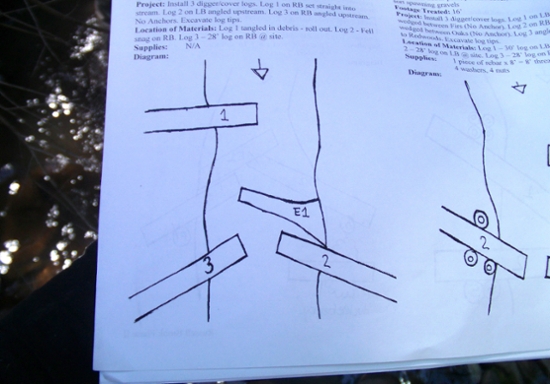 Figure 2: Large woody debris plans developed by the California Conservation Corps.
Figure 2: Large woody debris plans developed by the California Conservation Corps.
Continue reading The Siegel Salmon Restoration Internship: Part 2
Greetings from the Northern California Wilderness: The Siegel Salmon Restoration Internship
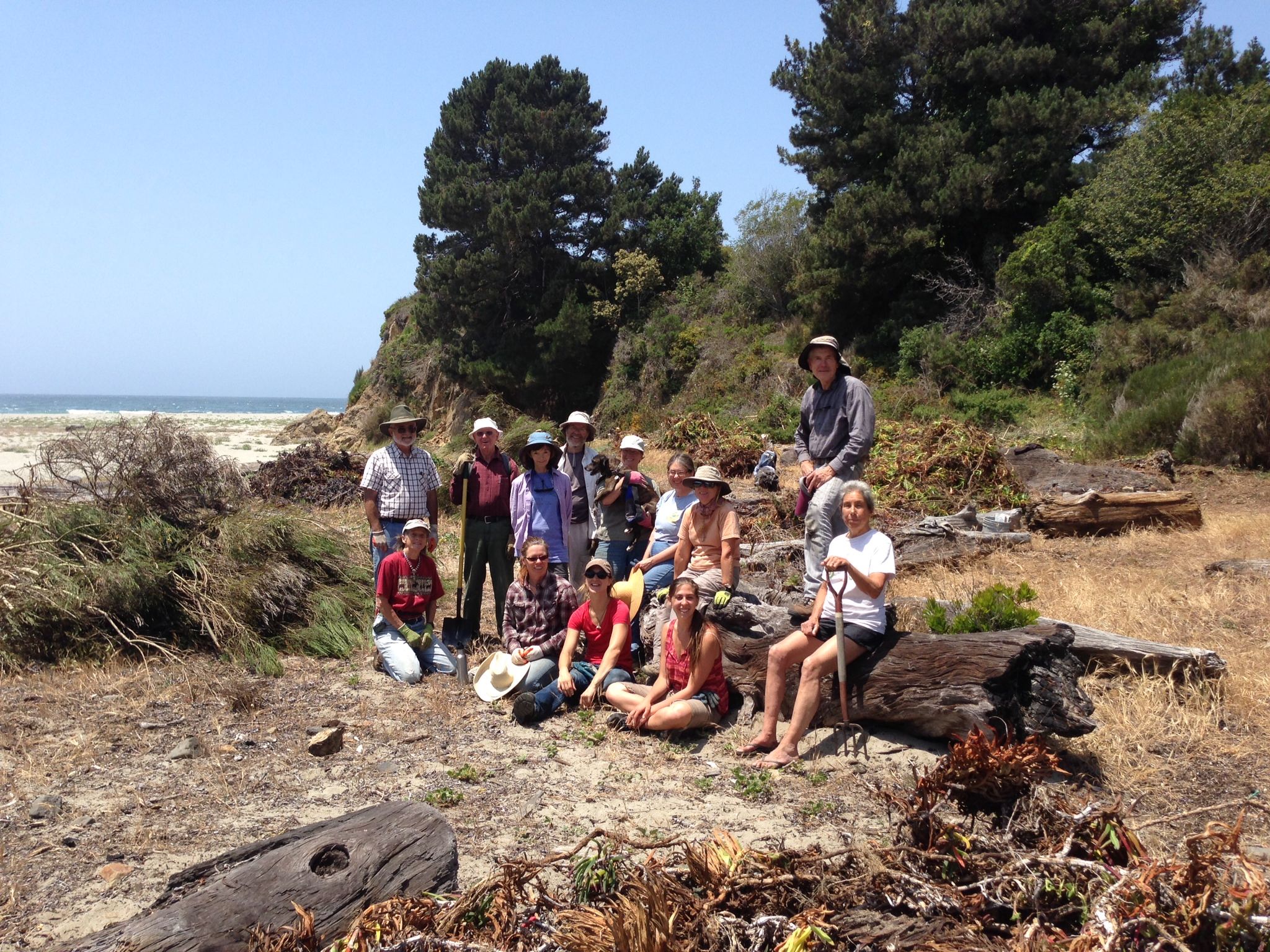
Hello from the Northern California wilderness! This past week and a half has gone by so quickly. The first thing that struck me was the natural beauty of this area. Every morning I get to run on the trails behind my cabin in Russian Gulch State Park, then I visit the beaches each afternoon. I can hear sea lions from my campfire spot, and see great blue herons on my way to work.
I spent most of last week settling into the office and meeting all the wonderful people who work here. I also got to tag along for a few bird surveys, which the Mendocino Land Trust is conducting with the help of some volunteers. I did manage to pick up a couple calls, and at the least can now distinguish between the chips of a squirrel versus those of a bird (harder than you may imagine). I also went out with a group from the Bay Area who were using their vacation time to do community service (part of a movement called “voluntourism”). They were a really friendly and lively group, and were incredibly helpful in removing the invasive species from the beaches (see photo).
Continue reading Greetings from the Northern California Wilderness: The Siegel Salmon Restoration Internship
Commerce Kitchen, Sofi Wright, Ch 2
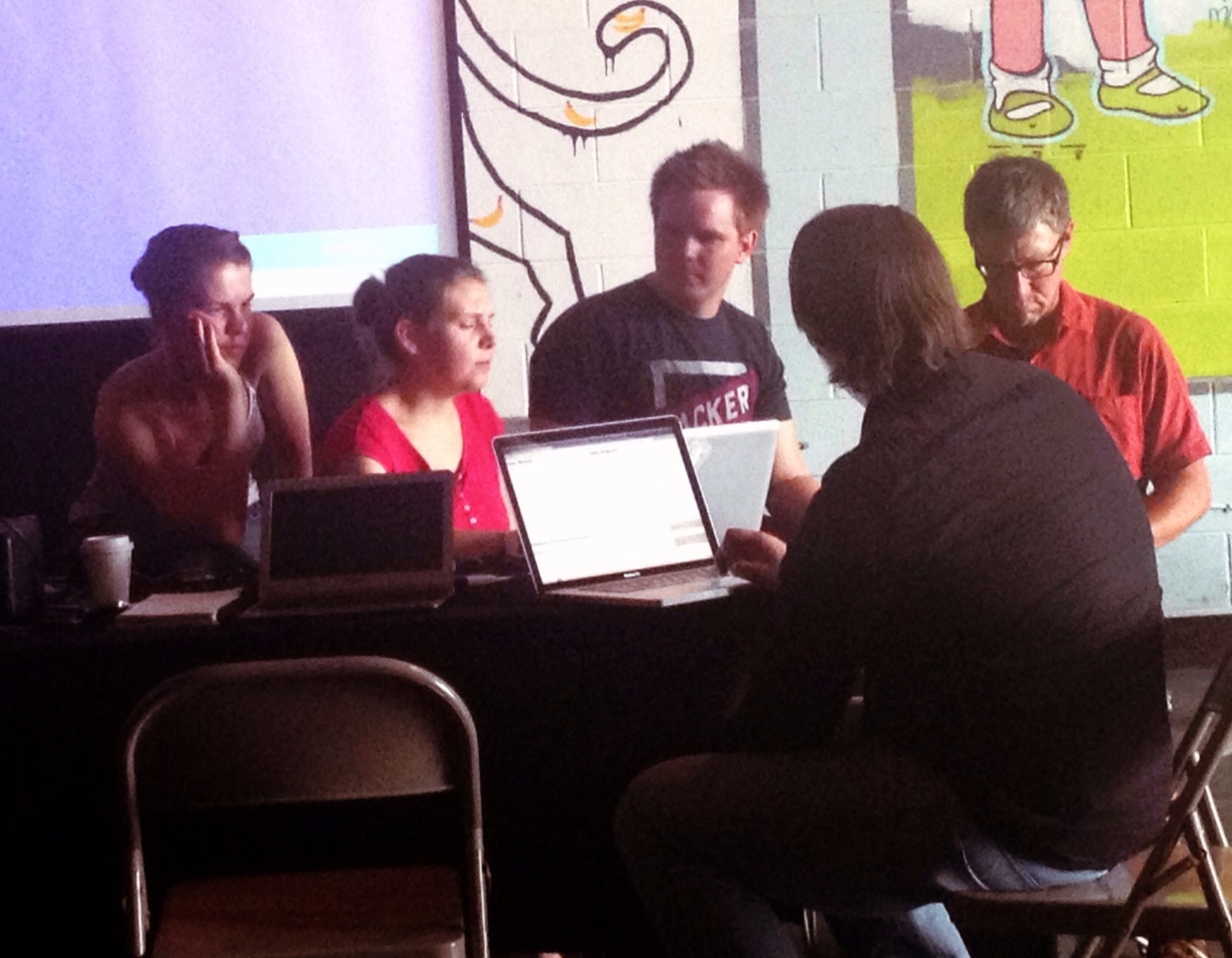
PREVIOUSLY on Sofi’s adventures in Denver: Sofi started as an intern at Commerce Kitchen, a web development and marketing company that is actually a group of superheroes. Her task, along with her fellow Reed intern Rebecca, was to research and produce what is known in the industry as “linkbait”—any online content cool enough that people will want to post links to it—a strategy for content marketing and search engine optimization. She was in the midst of creating a linkbait project when we left her last…
Something More Than Your Average Linkbait
Some weeks ago, we had our idea for a linkbait: drink recipes inspired by file format extensions (JPG, TXT, etc.)—it was nerdy and reflected the interests of Commerce Kitchen. We initially wanted to make it an infographic, but after a number of discussions on how best to promote the idea, it evolved from a simple online posting into something much bigger: a multi-week drink-making competition between local start-ups.
Continue reading Commerce Kitchen, Sofi Wright, Ch 2
De Paul Treatment Centers Internship, Ch 2
As the Freedom Award Luncheon looms closer, I am working harder than ever. I keep track of all our table sales and preparations. I've made so many spreadsheets, I almost never want to open Microsoft Excel again! I am learning about all of the organization it takes to prepare for this event, which will host somewhere around 470 people. All of the decorations and the menu must be ordered. Invitations need to be sent out. I'm sure that when I get back from vacation I will have a stack of RSVPs to wade through so that we can begin table seating arrangements.
Continue reading De Paul Treatment Centers Internship, Ch 2
Social Media and Outreach, SOIL, Chapter 2
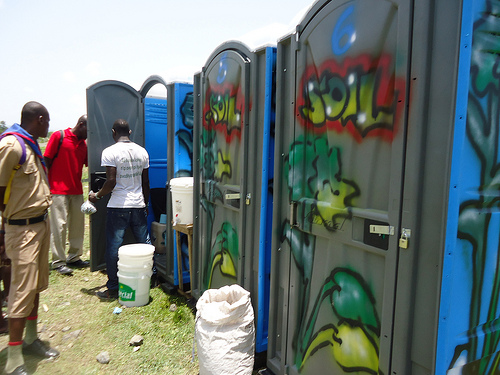
I’m five weeks into my Social Media and Outreach Internship with the 501(c)3 nonprofit Sustainable Integrated Organic Livelihoods (SOIL) and I couldn’t be more pleased to be working with such an effective, socially responsible organization. In my time here I’ve come to more fully appreciate the gravity of the global sanitation crisis, being that over 2.5 billion people across the globe lack improved sanitation facilities. In Haiti, over 70% lack access to a toilet leading to a high rate of child mortality from waterborne diseases. While SOIL’s contribution to mitigating this problem sometimes feel like a drop in the ocean in the context of these staggering data, the fact still remains that close to 7,000 Haitians are currently benefiting from SOIL’s products and services. In addition, SOIL focuses on designs and services with the potential to be scaled up through social business development so it’s exciting to see how this small project might help address the international challenge of increasing global access to sanitation.
SOIL implemented the first urban waste treatment site in all of Haiti in 2009. Considering how densely packed Port-au-Prince is, this is truly astounding to imagine. SOIL now operates two out of four waste treatment sites in Haiti. The capacity of these sites is clearly inadequate to suit the needs of the country, but Haiti is moving in the right direction with their new Water and Sanitation Authority and the public and private sector are working together more closely than ever to quell the cholera epidemic and implement long-term sanitation solutions.
Continue reading Social Media and Outreach, SOIL, Chapter 2
Sara Post, Zenger Farms Intern

Each point represents the address of a Food Scout participant. Colors groups addresses by zip code, and the black arrow points to the site of Lents Farmers Market
While half the work of running a youth education booth—called Food Scouts-- at Lents International Farmers Market is the improvisation of wacky games, the underlying other half of the work is data compilation. Because the program relies, somewhat begrudgingly, on funding from Whole Foods, it is my job to take note of participant numbers as well as their demographic each week. For example, I've now signed up 206 kids between the ages of 5 and 12, but we are still 94 short of the 300 goal. On July 28th, 15 new kids joined, but on July 21st, there were 24 new scouts. I might look at geographical outreach the week before (did I post fliers in neighboring communities close by? Did I post fliers in wealthy neighborhoods that already sustain flourishing markets?) and compare this outreach using map points with the home addresses that the parent/guardians of the Food Scouts share with me.
Continue reading Sara Post, Zenger Farms Intern
Christina Gremore, Social Venture Partners International Intern

I’m writing this blog post having just finished a check-in meeting with my supervisor. I was showing her my ideas about how SVP could adapt Salesforce.com’s powerful features and tools to foster a greater degree of collaboration between Partners, among staff, and across the network. For example: I’ve created a survey in Flow Designer that will automatically update the Partner’s record in our database with the kind of granular data around professional skills that helps SVP staff make a solid match between Partners and Investees. With more accurate and easily searchable information, SVP can more efficiently reach out to Partners and avoid letting those with valuable skills go untapped.
I’ve also been looking into Salesforce’s Self-Service Portal. Originally designed to let customers interact with service reps when trying to resolve a case, I’m recommending that SVP use it to allow SVP staff and Partners to communicate with each other about an Investee Project. Right now, such communications happen mainly via email. Keeping these conversations in the central database will allow others across the network to access the knowledge captured in the projects.
Continue reading Christina Gremore, Social Venture Partners International Intern
Technical Documentation Sigenics, Inc.
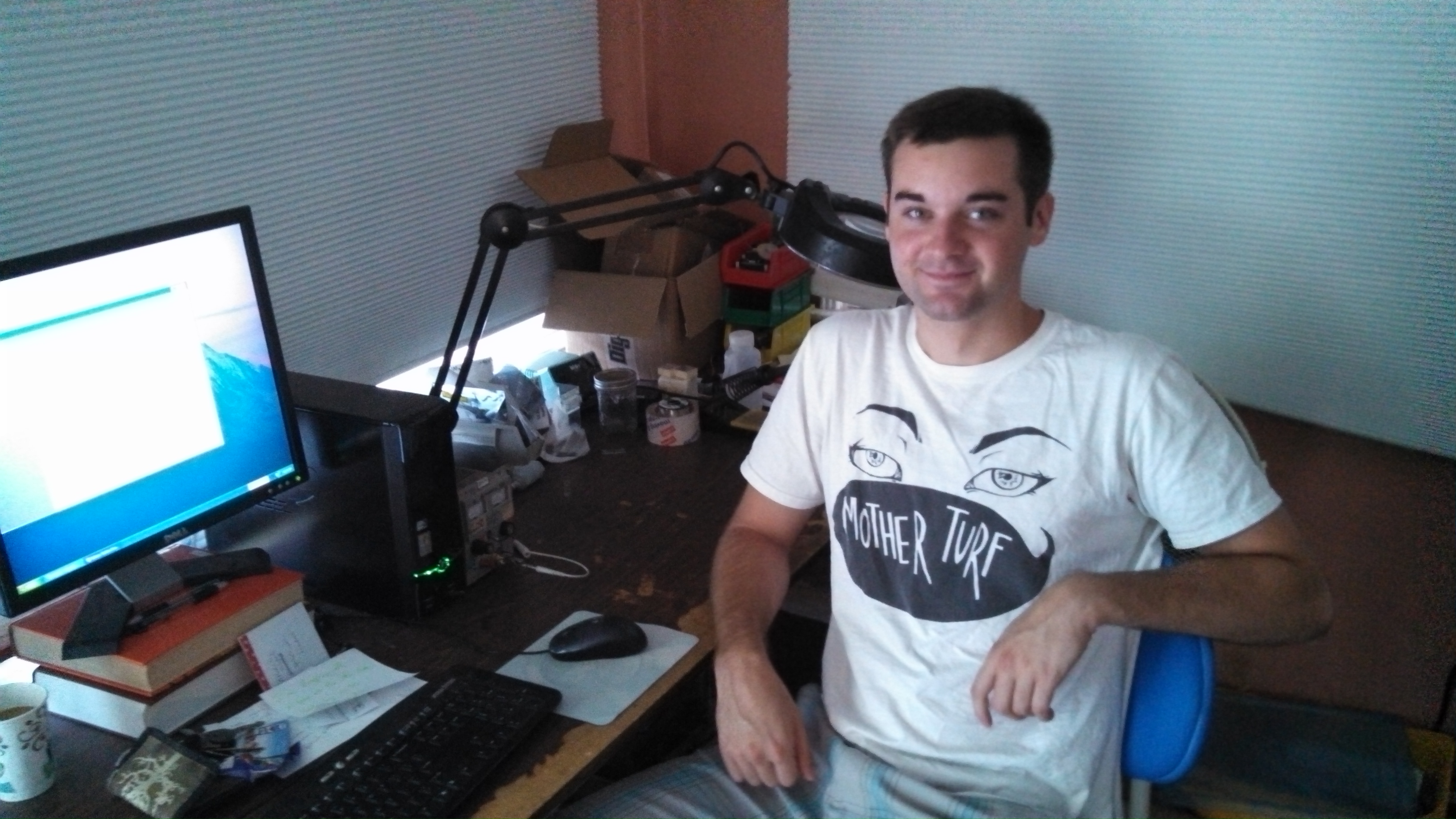
Aaron at work at Sigenics
Greetings from Sierra Madre, California, where I am currently interning at Sigenics Inc., a company excelling in the creation of custom silicon devices. When I first read the name ‘Sigenics Inc.’, I pretty much expected to find myself working amongst bustling lab-coated technicians scurrying around a clinically clean facility maintained by Wall-E-esqe robots... As it turns out, the Sierra Madre branch of Sigenics Inc. is more low-key—including me, it's a 3 man operation here, stationed in the guest house of my boss, the venerable Douglas Kerns. As far as bosses go, he’s awesome, the atmosphere is always relaxed, perhaps a side effect of working in this beautiful Los Angeles suburb. Doug tells me the Sierra Madre branch formed because he didn’t want to move out to Chicago—where the main facility of Sigenics is located—because the weather in SoCal was too nice to leave. Amen. Even after spending nearly every summer of my life here, I still don’t tire of it. Not long ago a Reed friend asked me, “Aaron, how come you never stay in Portland for summer? It gets so nice.”
“Well,” I replied, “it’s like that in L.A., too, we just call it ‘normal.’”
Continue reading Technical Documentation Sigenics, Inc.
Notes from Wehrli Lab, OHSU
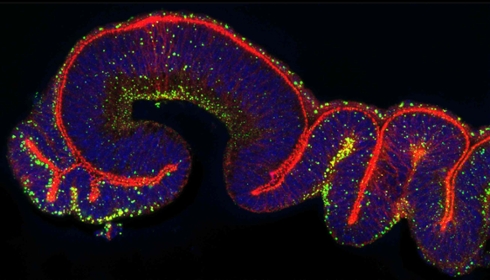
Fluorescence image of Drosophila wing disc in cross-section. Cell nuclei in blue, membranes in red, and a protein complex unique to Wnt signaling in green.
After several weeks in a fruit fly lab, I now feel quite confident in my ability to dissect larvae, create new crosses from different fly strains, and prepare tissues for microscopic imaging. Although I had never performed these techniques just two months ago, I now carry them out from memory on a regular basis. Without realizing it, I have learned how to identify many of the common Drosophila mutants that are used to create experimental crosses. I am also learning how to combine various protein or RNAi constructs in a single Drosophila line in order to interrupt or better visualize components of the Wnt signaling pathway. However, the most amazing thing to me is how much my dissection skills have improved. On my first day, I was shocked that I would be expected to remove organs from a larva only two or three millimeters long. Now, I can perform the task readily, although not nearly as quickly as my more experienced co-worker, Misha. I still have a lot to learn about the mechanisms involved in Wnt signaling. Understanding the research is far more difficult than simply carrying out the procedures. While I now know quite a bit about working with fruit flies, the complexities of the signaling pathway still elude.
Continue reading Notes from Wehrli Lab, OHSU
Food Scouts Internship at Lents Farmers' Market
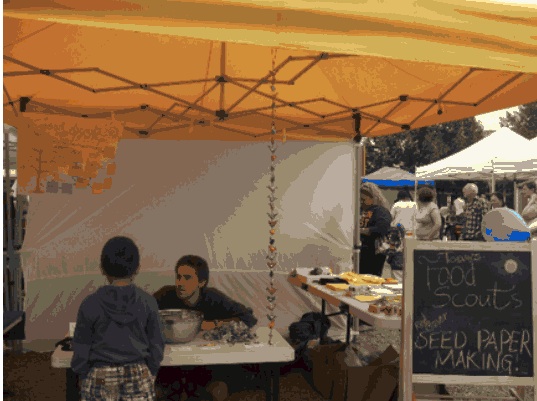
Volunteer Jimmy Villafranca (Reed '12) talks with the kid of a vendor before market begins Sara Post
I remember going to farmers' markets as a kid in central Pennsylvania. I remember being six and sulking at the knees of my father. Being at the market meant being stuck in a wave of grown-ups watching the straw bag at his side fill with green foods that I did not yet know how to convert into meals I would want to eat.
Working actively to reverse this—to get kids excited about farmers' markets and fresh vegetables on a large scale—is a worthy mission I have the opportunity to take on thanks to Reed’s Internship Advantage program. Reed has partnered with Zenger Farm to find a seasonal intern to develop the brand new “Food Scouts” program at the Lents International Farmers Market each Sunday. Geared for youth ages 5-12, Lents gifts each Food Scout with two $1 tokens to spend on vegetables, fruit, or food producing plants. Meanwhile, the scouts hang out at the Food Scout booth and participate in activities. They also get journals to take home and write or draw about produce. Underlying the play, the goal is the engage kids in the market—teach them why to care about plants, how to spend wisely, introduce them to other youth of the community.
Continue reading Food Scouts Internship at Lents Farmers' Market
SOIL Internship, Haiti
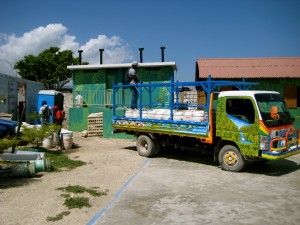
With funding from the Reed College Internship Advantage Initiative, for eight weeks this summer I am working as the social media and outreach intern for the 501(c)3 non-profit organization Sustainable Organic Integrated Livelihoods (SOIL), started by the inspiring Reed alumna Sasha Kramer. SOIL uses methods of ecological sanitation (EcoSan) to mitigate the ongoing sanitation crisis in Haiti that was only worsened by the 2010 earthquake. One of their most promising projects is the implementation of EcoSan toilets that turn human waste into much needed compost for sustainable agriculture.
Haiti came into the international limelight after the earthquake, and it seemed that every journalist and pundit felt entitled to present the public with their half-baked theories about why poverty persists in Haiti. International commentators have gazed at the Haitian poor with a mixture of disgust, pity, and fascination for centuries. In a 2010 New York Times article, David Brooks suggests that “Haiti, like most of the world’s poorest nations, suffers from a complex web of progress-resistant cultural influences.” And although he does recognize that Haiti has “a history of oppression, slavery, and colonialism,” he points out that “so does Barbados, and Barbados is doing pretty well.” His analysis, like too many others, blames the victim and clearly ignores the particular history of colonization, slavery that has brutalized so many Haitians, starting with the indigenous population that was decimated by the Spanish in the mid-sixteenth century. Brooks cites the “progress” of Barbados without explaining who is benefiting from that “progress.” Barbados has been hospitable to tourism and transnational capital, but their economy still favors accumulation of capital with the elite classes and the benefits of tourism are not necessarily distributed equitably. It is not justified for arrogant observers like Brooks to patronizingly define universal “progress” and dictate what that should mean to Haitians.
Continue reading SOIL Internship, Haiti
Commerce Kitchen, Sofia Wright
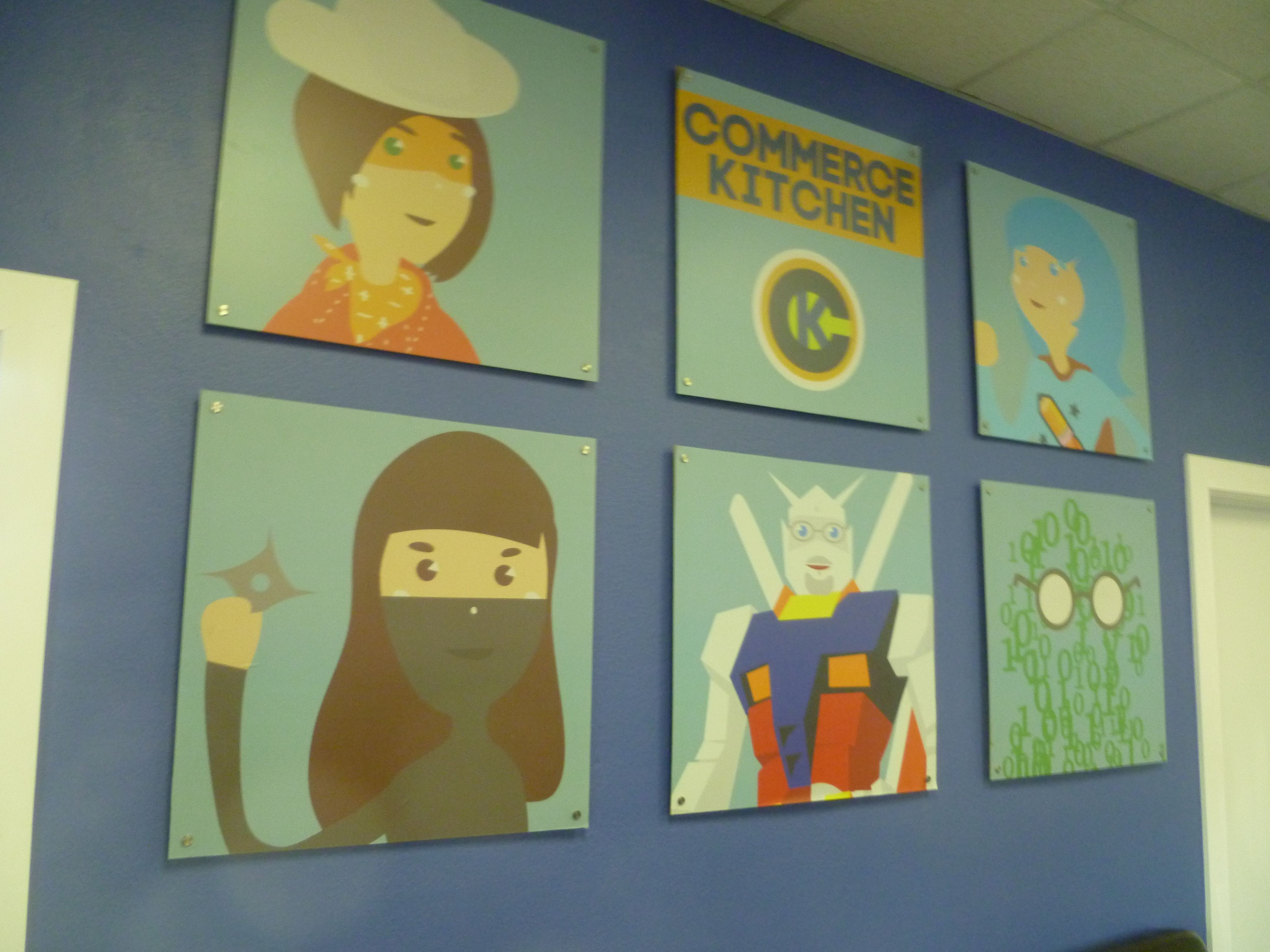
I am currently an intern at Commerce Kitchen, a web development and marketing company in Denver. My fellow intern (and fellow Reedie) Rebecca and I get to work there, and explore the city in our free time, for nine weeks this summer. The experience marks many firsts for me. First time visiting Denver. First summer living away from home. First paid internship. First experience working in marketing. And here, my first blog entry; it only makes sense to talk about my first impressions.
Continue reading Commerce Kitchen, Sofia Wright
DePaul Treatment Centers
My internship at De Paul Treatment Centers is a non-profit development (fundraising) internship made possible by Reed's Internship Advantage Initiative.
My first week at De Paul Treatment Centers was mostly filled with getting familiar with the office and who works there, and what their philosophy is. The orientation I attended really brought home their message of treatment for everyone. Although anyone can receive treatment at De Paul, their biggest mission is providing treatment to those who cannot afford it and who would otherwise go without treatment.
Continue reading DePaul Treatment Centers
Commerce Kitchen!
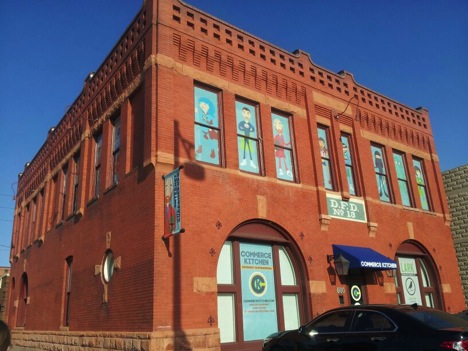
Hello!
Continue reading Commerce Kitchen!
First day: Christina Gremore, Social Venture Partners (SVP) Intern

When I initially read the SVP internship description on the Reed Internship Advantage page, my first reaction was, “That looks like a really interesting project!” My second reaction was, “I’m definitely not qualified to do any of that.”
Continue reading First day: Christina Gremore, Social Venture Partners (SVP) Intern
Wehrli Lab Notes, Daniel Lybrand '13
I am currently working at OHSU in the lab of Marcel Wehrli, Ph.D. The lab studies development in Drosophila (fruit flies) and focuses on the Wnt signaling pathway, one that features prominently in developmental biology research. My first week at OHSU has introduced me to a completely new area of biology. Most of my prior research experience has been in plant physiology. I have never worked with Drosophila before and know almost nothing about their development, so I am guaranteed to learn something new every day.
As a novice in the field, I learn from both Marcel and his research assistant, Misha (also a Reedie). I don’t yet have a project of my own, so I usually assist Misha with her experiments. Some of what I learn is completely new – techniques that I have never seen before.
In the past week, I have learned how to distinguish between male and female flies, how to tell a virgin from a fly that has never mated, how to dissect a fly larva, and how to identify the imaginal discs within the larva that eventually develop into various appendages. Other things are familiar but must be re-learned, as different labs carry out basic protocols in different ways. Antibody staining fruit fly larvae is very different from staining plant tissues!
Continue reading Wehrli Lab Notes, Daniel Lybrand '13
